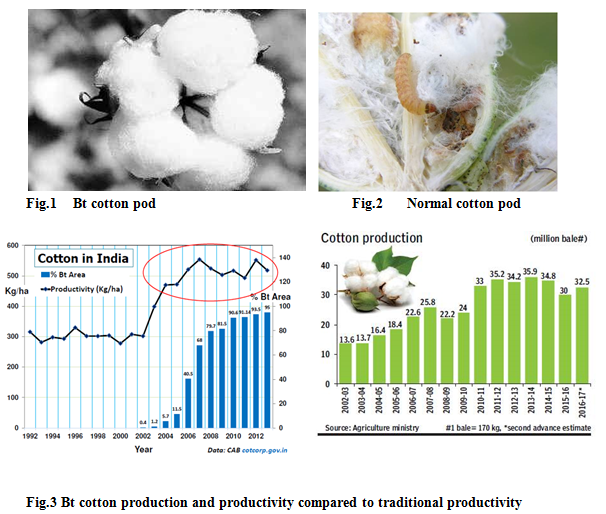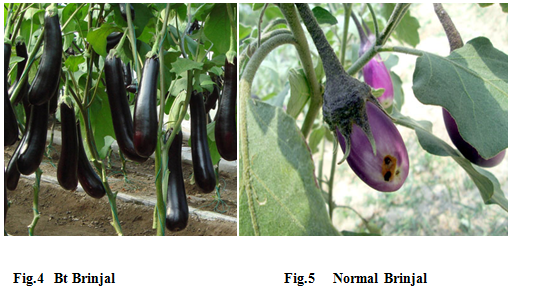Authors: Sourav Kumar Das
Msc research scholar, Division of molecular biology and biotechnology
ICAR-Indian Agricultural Research Institute
Email id-souravkumardas001@gmail.com
The introduction of Genetically Modified (GM) crops have kick started a huge controversy across the world. Genetic Engineering as a technology and its products, Genetically Engineered/modified organisms, are yet to answer many a questions on their impacts to environment and human health. The unpredictability and irreversibility of Genetic Engineering and the uncontrollability of GE crops in the environment coupled with studies pointing at the potential risk to human health and environment has resulted in a controversy across the world around the need for introducing such potentially risky organisms. Added to this is also the corporate sector control of the seeds, the most important input in agriculture, through this technology. Due to this growing scientific evidence on the lack of safety of GM crops and reality of corporate monopoly in seeds, majority of countries have shunned this so-called gene revolution path for agricultural development.
So far, most of the commercial applications involve herbicide tolerance and insect resistance, but other GM traits are in the research pipeline and are likely to be commercialized in the short-term to medium-term future. The rapid global spread of GM crops has been accompanied by an intense public debate. Supporters see great potential in the technology to raise agricultural productivity and reduce seasonal variations in food supply due to biotic and abiotic stresses. Increasing demand for agricultural products, natural resource scarcities and additional challenges posed by climate change are the main threat which requires increases in productivity for achieving long-term food security. Aside from health and safety concerns, critics worry that the widespread use of GM crops will put India’s food supply largely in the hands of a few giant corporations that make the seeds. There is also the possibility of genetic contamination if the Bt genes cross pollinate with other varieties.
- Impacts of Bt cotton:

- Expected impacts of Golden Rice:
- Nutrition and health benefits:
- Cost-effectiveness:
- Bt Brinjal:

We’ve moved from dismal regulation of Bt cotton to outright delinquency in bid to commercialize HT mustard:
Myths and realities
GMOs carry risks of ‘unintended’ effects and toxicity, which confront us with a double problem: scientists don’t know what to look for, and health impacts become apparent only in the long term, such as cancer. California reaffirmed last month, despite GM behemoth Monsanto’s best efforts, that its glyphosate, considered the safest herbicide, will be included in a list of chemicals labelled as “cancer-causing”.
There is serious concern that Monsanto may have known for 30 years that glyphosate is an endocrine (hormone) disruptor; no regulatory agency anywhere regulates for endocrine disruption despite overwhelming evidence from Argentina of horrendous birth defects because of glyphosate used in herbicide-tolerant (HT) soybeans. In this context, Bayer’s glufosinate, the herbicide linked with Indian HT mustard, is an acknowledged neurotoxin banned in the EU. The Supreme Court-appointed technical expert committee recommended a ban on any HT crop in India for this among several other reasons.
The myths that have sustained the propaganda of a safe and highly productive GM crop technology for two decades - that it “will feed the world” - are fast dissolving. The current stable of GMOs comprises just two products, Bt (e.g. Bt cotton) and HT crops (HT mustard), and they account for nearly 99% of GMOs planted worldwide. Both, on empirical evidence (including India’s Bt cotton), are proven unsustainable technologies. There are promises of GMOs with traits for disease, drought etc., but these are complex, multi-gene traits and remain futuristic. What is abundantly clear is that traditional breeding outperforms GMOs hands down.
Campaign against genetically engineered food makes no sense’.
Genetically modified food is not only safe, but also necessary to address issues of malnourishment, particularly in developing countries, said Nobel laureate and molecular biologist Sir Richard John Robert
“We could do wonders to our food supply with GMOs,” Sir Roberts said, before adding that the campaign against genetically engineered food “makes no sense”. If you don’t want to eat GMOs, then don’t. But, don’t pretend they are dangerous. They are not. They are probably safer than traditional foods, he said. He also expressed dismay over the delay in the production of Golden Rice, a genetically engineered food crop with high amounts of vitamin A. The crop, Sir Roberts felt, could help address vitamin A deficiencies, which is a major cause for childhood blindness in developing country. He claimed that more than 15 million children had died or suffered globally due to vitamin A deficiency since 2002. “How many must die before we consider this a crime against humanity that should be prosecuted?, Sir Roberts asked. Further, Sir Roberts pointed out that food is not a problem in developed countries. “But, let us not forget the consequences of our actions for the developing countries,” he said before emphasizing the need for more “science in politics and less politics in science.” Sir Roberts also sought to make it clear that he does not endorse the capitalistic and monopolistic approach adopted by large companies like Monsanto with regard to GMOs.
Knowingly or unknowingly, we Indians are consuming the GM products which are imported from the countries where GM crops are commercialized. Another strong point regarding GM crop commercialization is that, American countries are consuming GM corps since 2 decades without any health and environmental issue.
Protests against them a crime against humanity, says Richard J. Roberts
Scientists and others, who are in favour of genetically-modified (GM) food crops, have got support from an unexpected quarter. Richard J. Roberts, who won the Nobel Prize for physiology or medicine in 1993, made a forceful case for promoting research on GM food crops and their use for public consumption, saying they were needed to at least take care of vitamin and other deficiencies in the developing world.
Conclusion:
As regarding to the food security debate of GM crops are concerned, no doubtly GM crops are the panacea for ensuring food security but they have to be commercialized for fulfilling our food security point. Several limitation and controversy regarding commercialization of GM crops hinders their commercial release. But if they are commercialized, certain events have a potential for ensuring the food security of rapidly growing Indian population.
About Author / Additional Info: